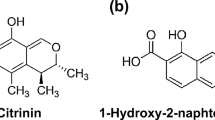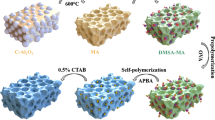Abstract
Due to ease of use and generally cost effective production molecularly imprinted polymers offer the possibility generating highly selective separation and enrichment materials. Therefore, they are considered a serious competitor to conventional biological agents such as antibodies, proteins and cells for affinity separations. Molecular imprinting applied in the present study is based on non-covalent self-assembly of the template with functional monomers prior to polymerization. Free radical polymerization with a cross-linking monomer is stabilizing (freezing) these template-functional monomer complexes, resulting in a mechanically and thermally stable polymer. After template extraction, rebinding may take place via non-covalent interactions.
Selective polymeric phases intended for use in solid-phase extraction of deoxynivalenol (DON) and zearalenone (ZON) from beverages have been prepared [1]. Using crystalline deoxynivalenol, zearalenone and quercetin, molecularly imprinted polymers (MIPs) have been developed by a non-covalent imprinting approach via photo initiated addition polymerization. Prepared polymers are based on 4-vinylpyridine (4-VP) as functional monomer and ethylenglycoldimethacrylat (EDMA) as crosslinking monomer. Selectivity of generated molecularly imprinted polymers has been investigated by application of prepared MIPs as stationary phase in high pressure liquid chromatography (HPLC) experiments. Retention and elution behavior of template compounds were determined and compared. Achieved results promise future application of molecularly imprinted polymers as highly selective matrix for clean-up and enrichment of deoxynivalenol and zearalenone from natural sources such as grains and beer.
Similar content being viewed by others
References
Weiss R, Mizaikoff B, Patent pending (2002) Receptors for Mycotoxins.
Mosbach K, Ramström O (1996) The emerging technique of molecular imprinting and its future impact on biotechnology. Biotechnology, 14: 163–170.
Andersson, L.I. (editor) 2000, Molecularly imprinted polymers: man-made mimics of antibodies and their applications in analytical chemistry. (Amsterdam: Elsevier Science).
Ramström O, Skudar K, Haines J, Patel P, Brüggemann O (2001) Food analyses using molecularly imprinted polymers. J. Agric. Food Chem 49: 2105–2114.
Molinelli A, Weiss R, Mizaikoff B (2002) Advanced solid phase extraction using molecularly imprinted polymers for the determination of quercetin in red wine. J. Agric. Food Chem. 50: 1804–1808.
Weiss R, Freudenschuss M, Krska R, Mizaikoff B (2002) Improving the Analysis of Mycotoxins in Beverages. Molecularly Imprinted Polymers for Deoxynivalenol and Zearalenone. Food Addit. and Contain., submitted
Author information
Authors and Affiliations
Corresponding authors
Rights and permissions
About this article
Cite this article
Weiss, R., Mizaikoff, B. Towards analysis of mykotoxins in beverages with molecularly imprinted polymers for deoxynivalenol and zearalenone. Mycotox Res 18 (Suppl 1), 89–93 (2002). https://doi.org/10.1007/BF02946071
Issue Date:
DOI: https://doi.org/10.1007/BF02946071




